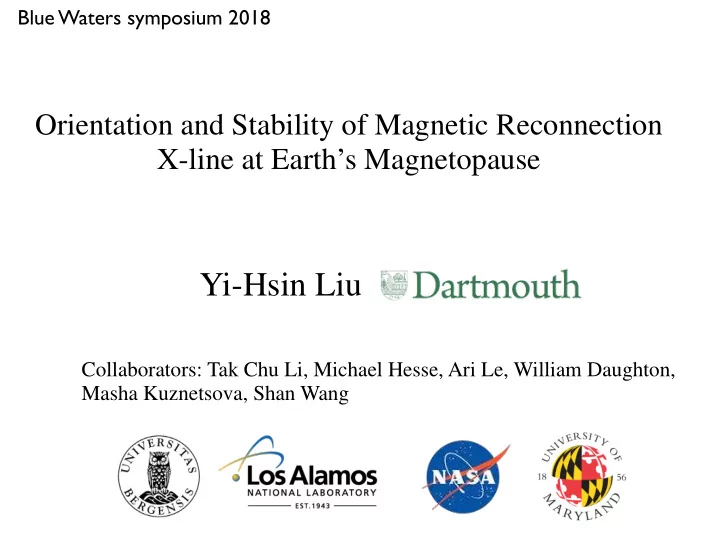

Blue Waters symposium 2018 Orientation and Stability of Magnetic Reconnection X-line at Earth’s Magnetopause Yi-Hsin Liu Collaborators: Tak Chu Li, Michael Hesse, Ari Le, William Daughton, Masha Kuznetsova, Shan Wang
Why it matters?
Magnetic Reconnection.? — an efficient mechanism that converts magnetic energy to plasmas kinetic energy inflow J outflow outflow z field line acts like slingshot X-line x inflow 1. Inflow brings in magnetic flux 2. Field lines break & reconnect 3. Reconnected field line shoots out plasma 4. Pressure drop sucks in plasma inflow 1. Inflow brings in magnetic flux 2. ..... 3. ... A self-driven process!!!
Earth’s magnetosphere IMF (Interplanetary Magnetic Field) Sheath Earth Sphere • Reconnection occurs at both the magnetopause & magnetotail. • Reconnection at the magnetotail drives magnetospheric substorm & causes aurora. • Space Weather: a strong geomagnetic storm (e.g.,1859 Carrington Event, 1989 Quebec blackout) could do damage to satellites , astronauts, GPS system, power grids on Earth ....etc
A billion $ NASA mission designed to study magnetic reconnection Magnetospheric Multiscale Mission (MMS) March 12, 2015 ATLAS rocket @ Kennedy Center, FL http://mms.gsfc.nasa.gov tight tetrahedron formation: separation down to 7 km! 100x faster for electrons measurement (30 ms) 30x faster for ions measurement (150 ms) • MMS leads us into a stage where the 3D electron-scale structure of magnetic reconnection, in nature, can be measured in an unprecedented manner.
The trailer of MMS ...
Key Challenge, Why Blue Waters? & Our accomplishments to date
Particle-in-cell Simulations ( v , x ) ( E , B , J , 𝜍 ) Lorentz Force ion e- F = q ( E + v × B ) Maxwell Equation Pro: A first-principle description with rich kinetic physics being captured ✔ Con: It demands considerable computational resource ,especially for 3D systems (Challenge!)
The 3D nature of magnetic reconnection -- how it differs from the conventional 2D picture?
3D nature of reconnection X-line Q: What determines the orientation of the x-line?? Hypothesis: the system may tend to maximize — the reconnection rate.? (current — the outflow speed.? 3D case density) — principle of maximum entropy? | J | — or ...?? An oblique 2D plane 2 64 d i • Simulation on BW provides a 1.2 first-principle test! 0.4 θ x-line 16 d i z x 64 d i -y (3D view using ParaView)
The question to solve sphere side sheath side sphere side sheath side Q: Which plane does reconnection “preferred”??
Result I: X-line Orientation sphere (side2) sheath (side1) • A well-defined x-line orientation develops!! (Liu et al., JGR, 2018)
Temporal Evolution |J| (Liu et al., JGR, 2018) • Check out the stability of this x-line~
What can companion 2D simulations tell us? Reconnection electric field i.e., a measure of the reconnection rate (Liu et al., JGR, 2018) • 2D simulations suggest that the 3D system selects a state with (or at least near) the maximal reconnection rate ! —i.e., maximizing the energy release!
Numerical experiment with Quasi-2D boxes -- laminar vs. turbulent x-line!? y x In comparison... (Liu et al., JGR, 2018) • Small periodic systems have often over-estimated the turbulence level.
Result II: Spread of reconnection x-line in Earth’s magnetopause geometry time spread distance along the x-line Work-in-progress: What determines the spread speed of the x-line?? — Alfv é n speed? — Current carrier speed? — Or ... something else?
Result III: Defining the x-line in the turbulent layer (*parameters chosen to match real MMS events) Lyapunov exponent of field lines x-line! (Le et al., Physics of Plasmas, 2018) • Turbulence caused by the lower-hybrid drift instability (LHDI). • Using Lyapunov exponent of field lines (Quasi-separarix layer) to trace the turbulent x-line.
Result IV: Reconnection rate in laminar 2D vs. turbulent 3D x-line (*parameters chosen to match real MMS events) E (Le et al., Physics of Plasmas, 2018) • Surprisingly, 3D turbulence does not affect the global reconnection rate! ( ps: the rate measurement based on the electron mixing on the sphere side does not work because of the cross-field transport by the turbulence )
Broader Impact Space Science Astrophysics Fusion device Crab Nebula e.g,, ITER Tokamak @ France Fermi Gamma Ray Space Telescope Super flares! Geomagnetic storms, substorms! magnetic field lines geometry in a cross section Solar flares!
Summary Magnetic Reconnection is the key process that releases the magnetic energy stored in space, astrophysical and laboratory plasma systems. — The 3D nature of magnetic reconnection remains unclear! — Blue Waters provides the opportunity to explore this challenging problem. Using Blue Waters, we have studied: — The orientation of 3D x-lines. *the 3D system tends to maximize the reconnection rate! — The spread of 3D x-lines. — The laminar vs. turbulent x-lines. — 3D reconnection rate. Broader Impact: — for instance, help interpret the 3D geometry in MMS observations. • Y.-H. Liu et al., Orientation and stability of asymmetric magnetic reconnection x-line , J. Geophysical Research, doi: 10. 1029/2018JA025410 (2018) • A. Le et al., Drift turbulence, particle transport, and anomalous dissipation at the reconnecting magnetopause , Physics Plasmas, 25, 062103, (2018) • T. C. Li et al., Spread of asymmetric magnetic reconnection x-line , work in progress (2018)
Progress of Particle-in-Cell simulations Courtesy to W. Daughton • VPIC: ~8 million particle pushes/sec, MPI + OpenMP hybrid architecture. • Resource required for a typical run in our BW project: ~2 trillion particles; ~ 6 billion cells; ~12 million CPU-hours; using ~260 K cores; ~200 TB output (including restart files)
Blue Waters Team Contributions Special thanks to Creg Bauer & Michelle Butler & storage group for fixing the error in my file system at Nearline, for accommodating larger Nearline storage. Ryan Mokos for the help & advices on the data archiving. JaeHyuk Kwack for the script that simultaneously launches tar comment in multiple cores! Roberto Sisneros & visualization group for helping setup the 3D visualization using ParaView.
Recommend
More recommend